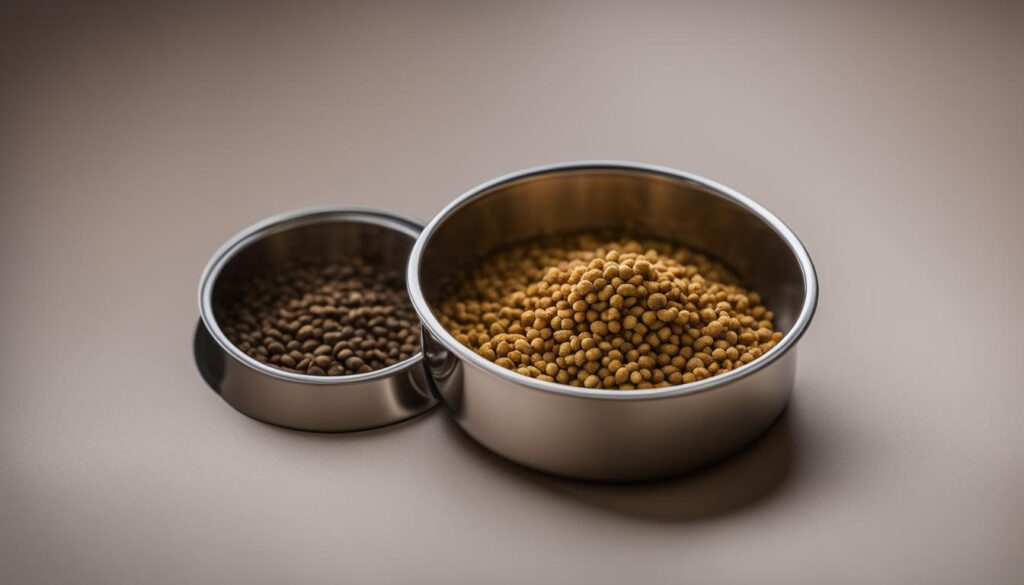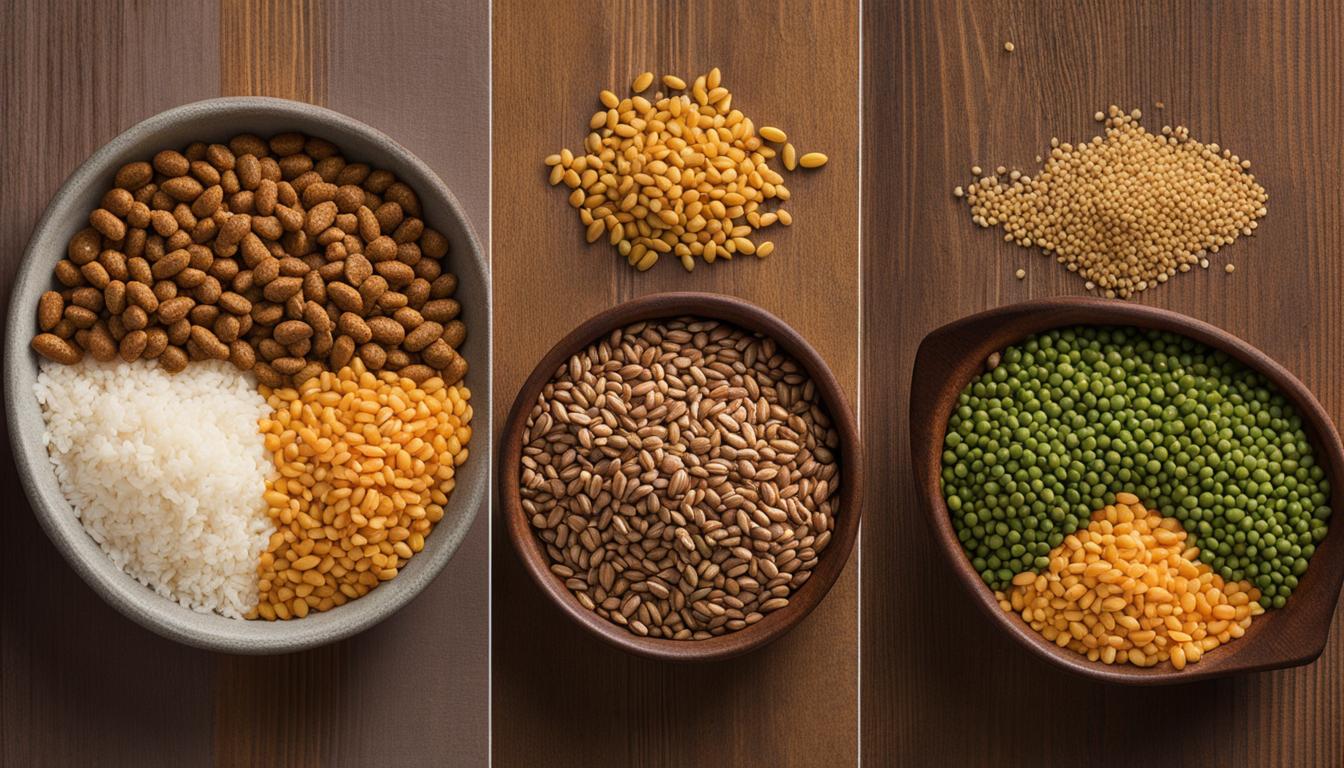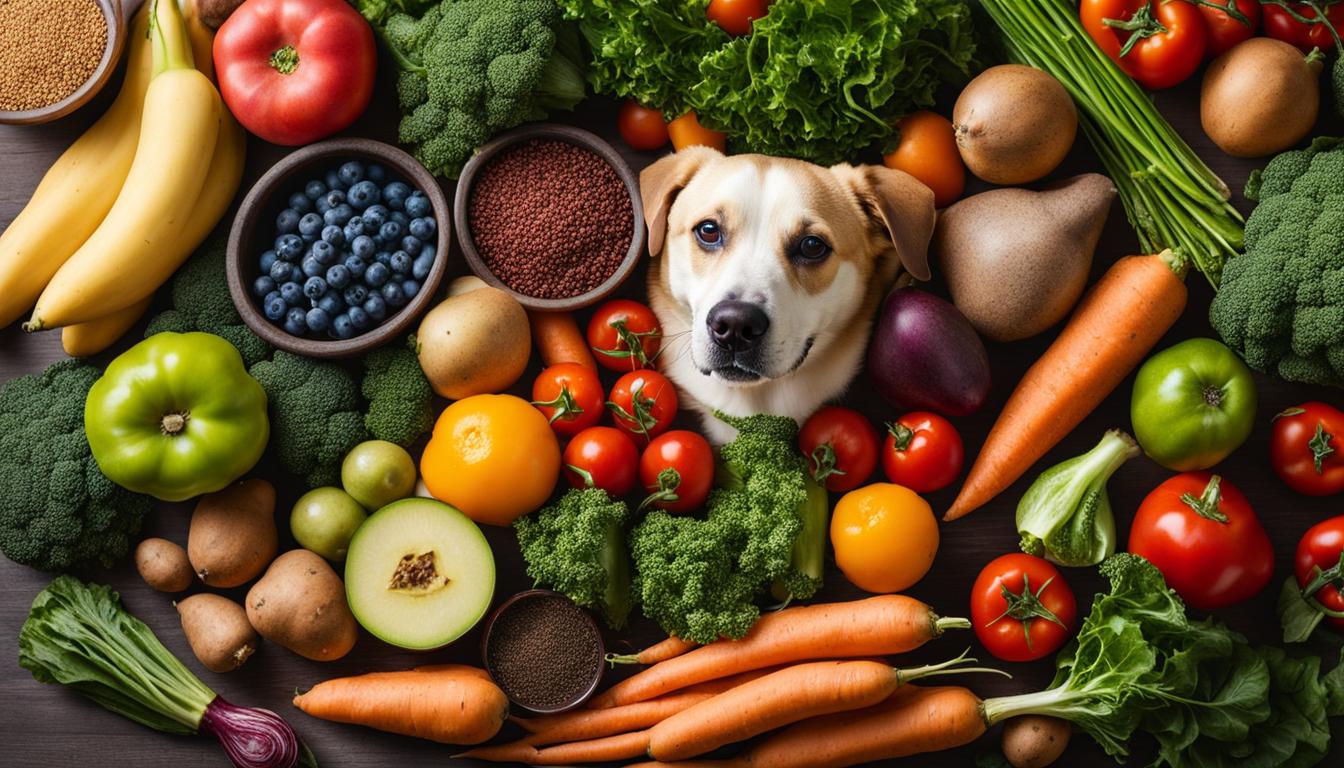Pet owners often find themselves torn between the choice of grain-inclusive and grain-free diets for their dogs. The debate centers around the belief that grain-free diets are healthier than grain-inclusive diets. However, the key to optimal pet nutrition lies in providing a variety of carbohydrate sources. By implementing a rotational feeding plan that includes both grain-inclusive and grain-free options, dogs can benefit from a diverse range of nutrients. This ensures their overall health and happiness.
Key Takeaways:
- Choosing between grain-inclusive and grain-free diets can be challenging, but the key is providing a balanced and varied diet.
- Implementing a rotational feeding plan that includes both grain-inclusive and grain-free options can optimize your pet’s nutrition.
- Grain-inclusive diets offer several benefits, including fiber, vitamins, proteins, antioxidants, and minerals.
- Grain-free diets may be beneficial for dogs with ingredient sensitivities, but they may lack certain nutrients.
- Consulting with a veterinarian and selecting dog food from reputable manufacturers is important for your pet’s well-being.
The Pros and Cons of Grain-Free Dog Food
Grain-free dog food has become increasingly popular among pet parents, and for good reason. Many dogs with ingredient sensitivities find relief when switched to a grain-free diet. The absence of grains eliminates potential allergens, making it easier for dogs with sensitive stomachs to digest their food. This can be especially beneficial for dogs suffering from digestive issues, as a grain-free diet can help alleviate symptoms such as gas, bloating, and diarrhea.
However, it’s important to consider the potential drawbacks of grain-free dog food. One disadvantage is the possible nutritional imbalance. Grain-free diets often have a higher protein content and calorie count, which may not be suitable for dogs with certain health conditions or those prone to weight gain. Additionally, by eliminating all grains, dogs may miss out on valuable nutrients necessary for heart health, such as taurine, which is primarily found in grains like rice and oats.
Quote: “While grain-free diets can be beneficial for dogs with specific sensitivities, it’s crucial to ensure they receive a balanced and complete diet to maintain their overall health and well-being.” – Dr. Linda Reynolds, DVM
It’s important to note that not all grain-free dog foods are created equal. Some may use alternative carbohydrate sources like legumes and potatoes, which can provide the necessary energy and nutrients while still being gentle on the digestive tract. However, it’s essential to choose a high-quality grain-free dog food from a reputable manufacturer that undergoes nutritional testing to ensure it meets the necessary standards for complete and balanced nutrition.

Comparing Grain-Free and Grain-Inclusive Diets for Digestive Health
| Grain-Free Dog Food | Grain-Inclusive Dog Food |
|---|---|
| Does not contain grains like wheat, corn, and rice | Includes whole grains like oats, barley, and brown rice |
| Can be beneficial for dogs with ingredient sensitivities | Provides a source of fiber for healthy digestion |
| Potential higher protein and calorie content | Offers a balanced nutritional profile |
| Risk of nutritional imbalances | May contribute to weight control |
| May lack essential nutrients like taurine for heart health | Provides a variety of necessary vitamins and minerals |
When deciding between grain-free and grain-inclusive dog food, it’s important to consider your dog’s specific needs and consult with a veterinarian. They can help you determine the best diet for your furry friend, ensuring they receive the necessary nutrients for optimal health and well-being.
The Benefits of Grain-Inclusive Dog Food
When it comes to providing optimal nutrition for your furry friend, grain-inclusive dog food offers a range of benefits. Whole grains, such as oats, barley, and brown rice, are packed with essential nutrients that contribute to your dog’s overall health and well-being. These ingredients are rich in fiber, vitamins, proteins, antioxidants, and minerals, which play a vital role in supporting their digestive health.
By including whole grains in your dog’s diet, you can help regulate their blood sugar levels and promote a healthy gut. The fiber content in grain-inclusive dog food aids in digestion and can prevent common digestive issues, such as constipation and diarrhea. Not only do whole grains support your dog’s digestive health, but they also provide a cost-effective option for pet parents.
Compared to grain-free options, grain-inclusive dog food is often more budget-friendly without compromising on nutritional value. This makes it an excellent choice for pet owners who want to provide their dogs with a balanced and cost-effective diet. With the variety of whole grains available, you can ensure that your dog receives a diverse range of nutrients to support their overall health and happiness.

Grain-Free Diets and Heart Health
Grain-free diets have become increasingly popular among pet owners in recent years. However, concerns have been raised regarding the impact of these diets on heart health in dogs. Studies have shown a potential correlation between grain-free diets and an increased risk of dilated cardiomyopathy (DCM), a serious heart disease that can be fatal.
Taurine deficiency has been identified as a possible link between grain-free diets and DCM. Taurine is an amino acid that plays a crucial role in heart function. While taurine is naturally found in many ingredients, including grains, the levels of taurine in grain-free diets may be insufficient to meet a dog’s requirements. This deficiency can lead to the development of DCM.
To mitigate the risk of heart disease in dogs on grain-free diets, it is essential for pet owners to be vigilant and seek guidance from their veterinarian. Regular check-ups and blood tests can help monitor taurine levels and detect any potential deficiencies. In some cases, taurine supplements may be recommended to ensure that the dog’s nutritional needs are met.
The Importance of a Balanced Diet
While grain-free diets may have their advantages, it is crucial to remember that a balanced diet is key to optimal canine health. Including a variety of ingredients, such as whole grains, lean proteins, fruits, and vegetables, can provide essential nutrients and promote overall well-being. Grain-inclusive diets, when formulated with high-quality ingredients, can offer a range of benefits, including a source of energy, fiber for digestive health, and important vitamins and minerals.
| Grain-Free Diets and Heart Health | Key Points |
|---|---|
| Grain-free diets have been linked to an increased risk of dilated cardiomyopathy (DCM), a serious heart disease in dogs. | Be cautious of the potential for taurine deficiency in grain-free diets. |
| Consult with your veterinarian and monitor taurine levels regularly if your dog is on a grain-free diet. | Regular check-ups and blood tests are crucial to ensure your dog’s heart health. |
| A balanced diet, including a variety of ingredients, is essential for optimal canine health. | Grain-inclusive diets can provide important nutrients and support overall well-being. |
The Role of Grains in Dog Nutrition
When it comes to dog nutrition, grains play a crucial role in providing essential energy and maintaining a balanced diet. Grains are a valuable source of carbohydrates, which are converted into glucose and serve as fuel for the body’s cells, tissues, and organs. This energy is vital for your dog’s daily activities, from running and playing to simply staying active and alert.
But grains offer more than just energy. They are also rich in vital nutrients that contribute to your dog’s overall health and well-being. High-quality grains, such as oatmeal, barley, and quinoa, contain fiber, vitamins, proteins, antioxidants, and minerals. These nutrients support various bodily functions, including healthy digestion, immune system functioning, and maintaining shiny coat and healthy skin.
To illustrate the nutritional benefits of grains, let’s take a look at the table below:
| Grain | Nutrients |
|---|---|
| Oatmeal | Fiber, iron, manganese, thiamine (vitamin B1) |
| Barley | Fiber, selenium, phosphorus, copper |
| Quinoa | Protein, fiber, magnesium, manganese |
As you can see, each grain offers a unique combination of nutrients, making them valuable additions to your dog’s diet. Including grains as part of your dog’s nutritional plan ensures that they receive a balanced and diverse range of essential nutrients for optimal health and vitality.
Rotating Between Grain-Inclusive and Grain-Free Diets
If you’re unsure whether to choose a grain-inclusive or grain-free diet for your dog, why not consider rotating between the two? Rotational feeding, also known as Full Circle Feeding, offers a variety of carbohydrate sources and brings numerous nutritional benefits to your furry friend.
By incorporating both grain-inclusive and grain-free options into your dog’s diet, you can provide a diverse array of nutrients. This diversity can be achieved by alternating between different ingredients such as quinoa, lentils, sweet potatoes, and rye. Rotational feeding can help ensure that your dog receives a well-rounded and balanced nutritional intake.
One of the advantages of rotational feeding is that it helps prevent your dog from developing sensitivities or intolerances to specific ingredients. By regularly switching between different diets, you reduce the risk of your dog’s body becoming overexposed to certain ingredients, which could potentially lead to adverse reactions or allergies.
| Benefits of Rotational Feeding | Benefits of Rotational Feeding |
|---|---|
| Provides a variety of nutrients | Promotes a healthy digestive system |
| Reduces the risk of ingredient sensitivities | Prevents nutritional imbalances |
| Helps maintain a healthy weight | Enhances overall well-being |
Remember, when implementing rotational feeding, it is important to transition gradually between diets to avoid any digestive upset. Start by introducing small amounts of the new food alongside the old food, gradually increasing the proportion of the new food over several days or weeks.
Consult with your veterinarian to determine the best rotational feeding plan for your dog’s specific needs. They can provide guidance on the appropriate types and quantities of food to include in your rotation, ensuring that your furry friend receives all the necessary nutrients for optimal health.

The Full Circle Feeding Approach
“Rotational feeding allows dogs to benefit from a variety of carbohydrate sources, ensuring a well-rounded nutritional profile. The Full Circle Feeding approach provides dogs with the best of both worlds, combining the advantages of grain-inclusive and grain-free diets. It’s like offering them a buffet of healthy choices!”
Choosing the Right Dog Food
When it comes to selecting the right dog food for your furry friend, there are several factors to consider. The nutritional content, quality of ingredients, and reputation of the manufacturer all play a crucial role in ensuring your pet receives the necessary nutrients for optimal health.
One important aspect to look for is nutritional testing. Reputable manufacturers conduct feeding trials to ensure their products meet the standards set by the Association of American Feed Control Officials (AAFCO) for complete and balanced nutrition. This testing helps to ensure that the dog food contains adequate levels of essential vitamins, minerals, and proteins.
It’s also essential to choose dog food from reputable manufacturers. Well-established brands like Purina, Hills, Royal Canin, Iams, and Eukanuba have a long history of producing high-quality pet food. These companies prioritize the health and well-being of pets and use standard ingredients like chicken, beef, rice, corn, and wheat.
Table: Key Considerations for Choosing Dog Food
| Consideration | Explanation |
|---|---|
| Nutritional Testing | Look for dog food that has undergone nutritional testing to ensure its compliance with AAFCO standards. |
| Reputable Manufacturers | Choose dog food from trusted brands with a proven track record in producing high-quality pet food. |
| Ingredient Quality | Inspect the ingredient list to ensure that the dog food contains wholesome and nutritious ingredients. |
| Specific Nutritional Needs | Consider any specific dietary requirements your dog may have, such as allergies or sensitivities. |
| Age and Size | Take into account your dog’s age and size when selecting the appropriate dog food formula. |
| Price | Consider your budget and find a dog food option that offers the best value for money without compromising quality. |
By considering these factors and making an informed decision, you can ensure that your beloved pet receives the best nutrition possible, leading to a healthy and happy life.
Conclusion
Choosing between grain-inclusive and grain-free dog diets can be a tough decision, but the key to ensuring your pet’s health is finding a balance. By providing a varied and balanced diet, you can maximize the nutritional benefits for your furry friend.
Rotational feeding, which involves alternating between grain-inclusive and grain-free options, is a great way to achieve this balance. By incorporating a variety of carbohydrate sources like quinoa, lentils, sweet potatoes, and rye, you can ensure your dog receives a diverse range of nutrients.
Remember to consult with your veterinarian and choose high-quality dog food from reputable manufacturers. This will help guarantee that your pet’s nutritional needs are met. Prioritize their health and well-being by making informed decisions and maintaining a nutritional balance.
So, whether you decide to go grain-inclusive or grain-free, the most important thing is to provide your pet with a wholesome diet that promotes their overall health and happiness. After all, a balanced diet is the key to a happy and healthy furry companion!
FAQ
Are grain-inclusive diets better for dogs with ingredient sensitivities?
Grain-free diets are often recommended for dogs with ingredient sensitivities because they eliminate common allergens like wheat and corn. However, some dogs may still have sensitivities to specific grains, so it’s important to consult with a veterinarian to determine the best diet for your pet.
Can grain-inclusive diets help regulate blood sugar levels in dogs?
Yes, whole grains like oats, barley, and brown rice have a lower glycemic index compared to refined grains. This means they are digested and absorbed more slowly, resulting in a more gradual and steady release of glucose into the bloodstream. This can help regulate blood sugar levels and prevent spikes and crashes.
Do grain-free diets pose a higher risk of heart disease in dogs?
There is some evidence linking grain-free diets to an increased risk of dilated cardiomyopathy (DCM) in dogs. The lack of grains in these diets may lead to a deficiency in taurine, an amino acid essential for heart health. It’s crucial to monitor your dog’s heart health and consult with a veterinarian when considering a grain-free diet.
Do grains provide essential nutrients for dogs?
Yes, grains are a good source of fiber, vitamins, proteins, antioxidants, and minerals. High-quality grains like oatmeal, barley, and quinoa contribute to overall nutritional balance in a dog’s diet.
How does rotational feeding benefit dogs?
Rotational feeding, which involves alternating between grain-inclusive and grain-free diets, provides dogs with a diverse array of nutrients from different ingredients. This helps optimize their overall health and well-being.
How can I choose the right dog food for my pet?
When selecting dog food, it’s important to choose products from reputable manufacturers that prioritize nutritional testing. Look for well-established companies that conduct feeding trials and use standard ingredients. Additionally, make sure the food meets the standards set by the Association of American Feed Control Officials (AAFCO) for complete and balanced nutrition.
What is the main goal in choosing pet food?
The main goal in choosing pet food is to ensure your furry friend receives the necessary nutrients for optimal health. Whether you choose a grain-inclusive or grain-free diet, the key is to provide a balanced and varied diet that meets your pet’s specific needs.





